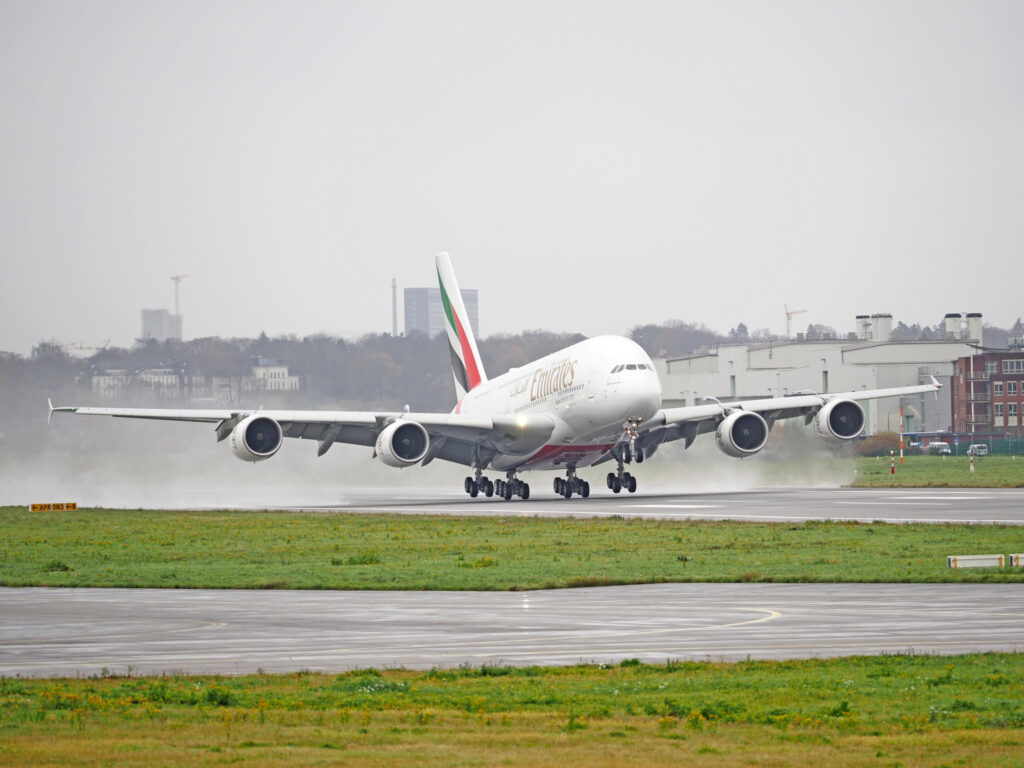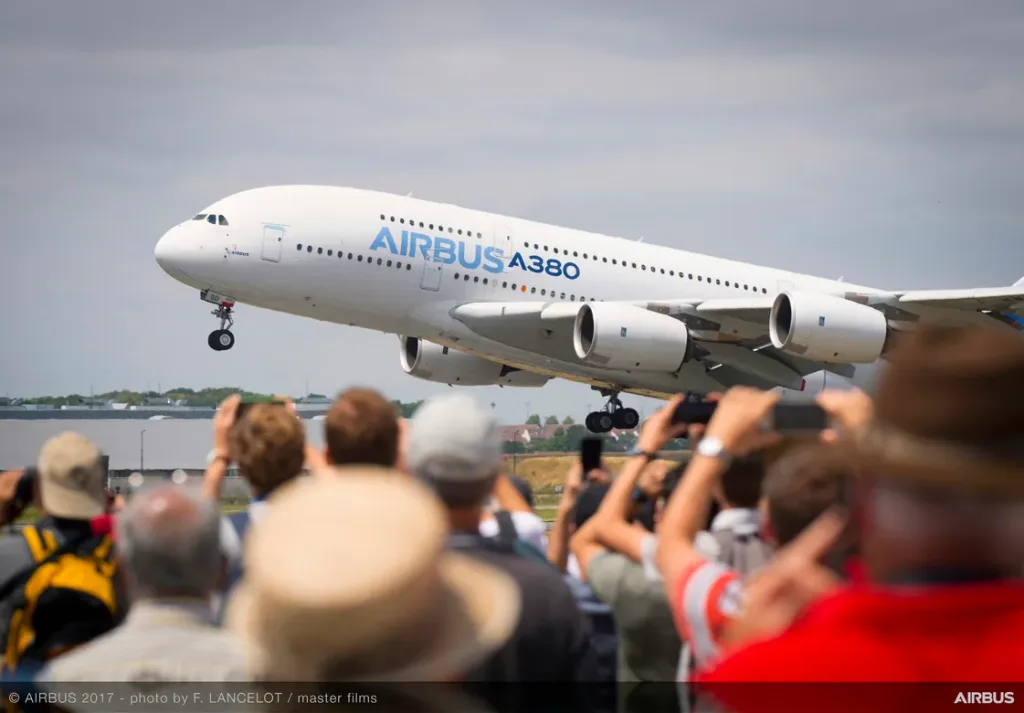Emirates has made headlines after the purchase four Airbus A380 superjumbos for a remarkably low total of $180 million. The deal, finalized with investment firm Doric Nimrod Air Three Limited, is for aircraft that have been leased by the Dubai-based carrier since 2013.
As the leasing contracts near expiration, Emirates decided to take the ownership of the superjumbos as part of its long-term investment in the A380 program even as other carriers are retiring the jets.

A Strategic Move: Lease to Ownership
The four Airbus A380s bearing registration A6-EEK, A6-EEL, A6-EEM, and A6-EEO were bought at $45 million each. This includes $25 million per aircraft for title transfer and $20 million for fulfilling lease return obligations. All four jets have been operating under 12-year leases since their delivery in 2013, and will officially join Emirates’ owned fleet between August and November 2025.
Moreover, one of them, MSN 133, is set for title transfer on August 27, with scheduled maintenance taking place outside of Dubai International Airport.
This deal allows Emirates to avoid going back to potentially worse leasing deals and to get more useful life out of already tailored planes to its standards. This move is a part of the airline’s overall plan of owning the majority of its widebodies, especially as it modernizes cabins and introduces A380s into long-term planning.
Emirates Airbus A380 Purchase Shows Market Reality
Originally valued over $400 million each, second-hand Airbus A380s now fetch a fraction of that price on the resale market. With the superjumbo no longer being produced since 2021 and very few buyers for the giant aircraft, the purchase amount Emirates paid of $25 million per aircraft reflects the current market conditions.
The additional $20 million per aircraft pays for compliance with end-of-lease return specs, something Emirates would have had to pay either way.
Moreover, this acquisition gives Emirates the flexibility to upgrade the aircraft without getting into third-party leaseholder approvals. The airline is currently in the process of a $2 billion fleet retrofit program, one that will upgrade cabins and extend aircraft life cycles.

Emirates Doubles Down on the A380
While other global airlines grounded their A380s following the pandemic, Emirates is going against the tide. The Middle Eastern carrier operates the largest fleet of A380s in the world, with 116 active aircraft as of July 2025. This represents nearly half of the entire production of the A380.
Earlier, the airline has signalled plans to retire the type by the mid-2030s but has now pushed it to 2040. These four newly purchased A380s are equipped with Engine Alliance GP7200 engines and have a seating capacity of 489 passengers divided among three classes: 14 First, 76 Business, and 399 Economy.
Additionally, all four of them have accumulated between 40,000–43,000 hours and 4,600–5,200 cycles, far below service thresholds for additional long-haul use.
Doric Nimrod Air Three: A Long-Term Leasing Partner
The sale was made to Doric Nimrod Air Three Limited, an investment fund established by Germany-based Doric GmbH and UK-based Nimrod Capital LLP of Guernsey. The company purchased the four planes outright from Airbus in 2013 and leased them to Emirates since the day one of operations.
Following this sale, Doric Nimrod Air Three will be wound up, with returns to shareholders in early 2026. This is not Emirates’ inaugural purchase of Doric jets. Last year, the carrier bought five A380s from Doric Nimrod Air, Two for approximately $200 million and two more from Doric Nimrod Air One for $70 million aggregate.
These serial purchases reflect Emirates’ plan to decrease its reliance on leasing and solidify its ownership of key widebody assets.

A380 Still at Heart of Emirates’ Network
As global exposure for the A380 continues to shrink, it remains at the heart of Emirates’ hub-and-spoke network through Dubai International Airport (DXB). The aircraft continues to serve high-demand routes to London Heathrow (LHR), Sydney (SYD), and New York (JFK), with recent additions to Copenhagen (CPH) destinations.
The superjumbo’s massive size and lavish cabin configuration enable Emirates to offer a product differentiation, particularly for its premium segment.
With the acquisition of these four A380s and the refurbishment of existing aircraft, Emirates is reaffirming its unique niche in the global aviation industry. The airline still appreciates operating the A380 over trunk routes which experience strong passenger traffic and benefit from the advantages of the superior onboard capacity of the airplane.
Long-Term Fleet Planning, Market Signaling
Emirates’ purchase holds promise of a long-term market rebound for premium long-haul and high-capacity travel. With growing demand in Asia, Europe, and North America, having a healthy A380 fleet ensures Emirates will be able to seize future volumes without compromising the passenger experience.
Parallel with that, the airline is putting into service its newer generation of aircraft, with Airbus A350-900s being the latest. Boeing 777Xs are expected to be delivered starting in 2026. Nevertheless, the A380 has a unique niche in Emirates operations, fulfilling luxury, brand, and volume needs in a manner the other planes cannot.
Summary: Emirates Airbus A380 Purchase
| Aircraft | MSN | Registration | Delivery | Purchase Price | Engine | Seat Configuration |
|---|---|---|---|---|---|---|
| 1 | 132 | A6-EEK | Aug 2013 | $45 million | GP7200 | F14 / C76 / Y399 |
| 2 | 133 | A6-EEL | Nov 2013 | $45 million | GP7200 | F14 / C76 / Y399 |
| 3 | 134 | A6-EEM | Nov 2013 | $45 million | GP7200 | F14 / C76 / Y399 |
| 4 | 136 | A6-EEO | Oct 2013 | $45 million | GP7200 | F14 / C76 / Y39 |
Emirates’ acquisition of these four A380s reinforces its long-term commitment to the double-decker plane and its asset ownership-expansion strategy in balance with customer experience.
As other airlines are walking away from the A380, Emirates is still reorganizing its fleet around this legendary plane. This demonstrates its confidence in an age where high-capacity, premium-heavy travel is still a large part of the future.
Please join our Telegram Channel for the latest aviation updates.
Source: Simple Flying

2 Comments
Pingback: Emirates Hiring 17,300 New Employees in 2025 - Aero World
Pingback: Retirement to Revival: Etihad to Reactivate More Airbus A380s - Aero World